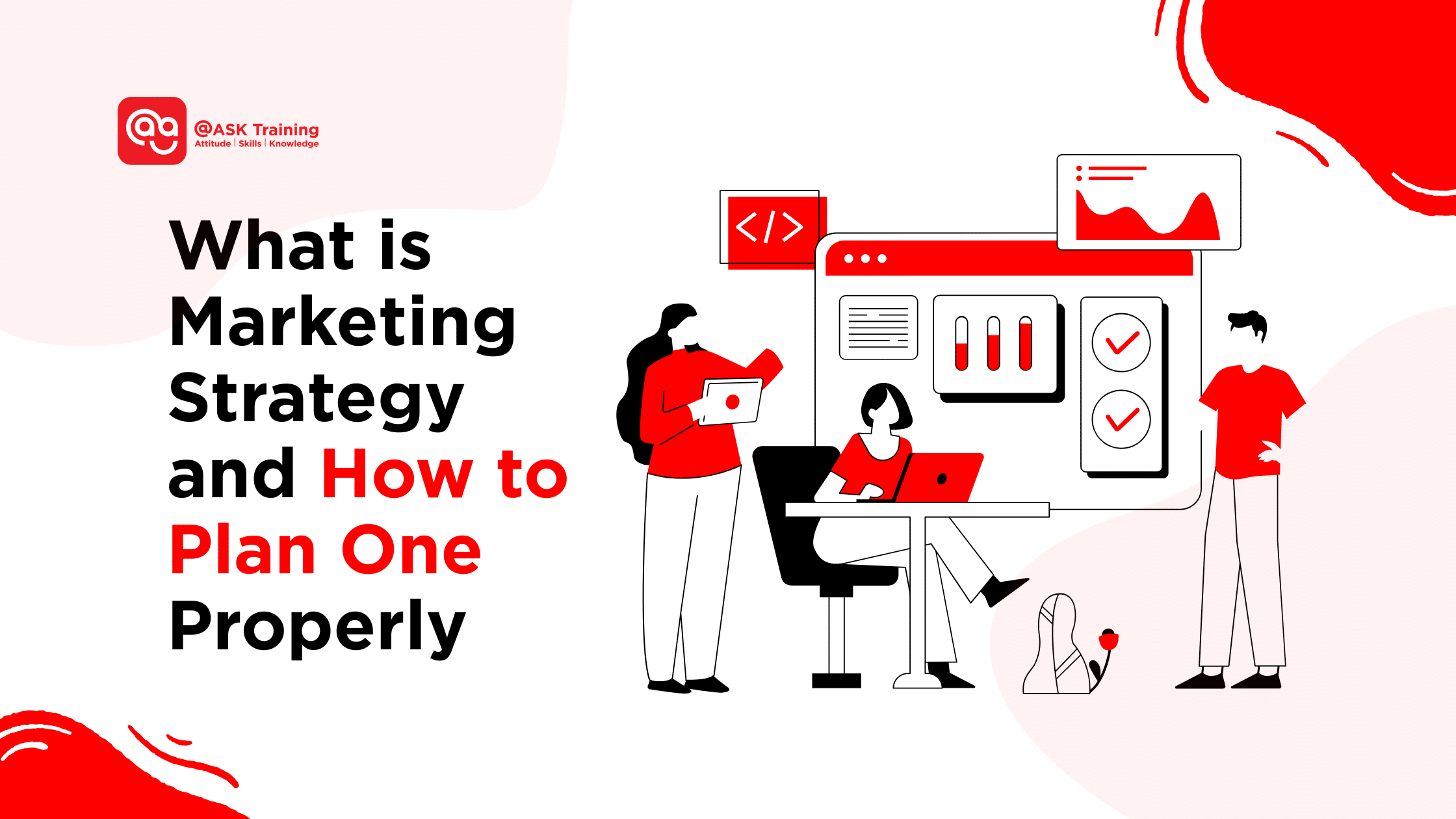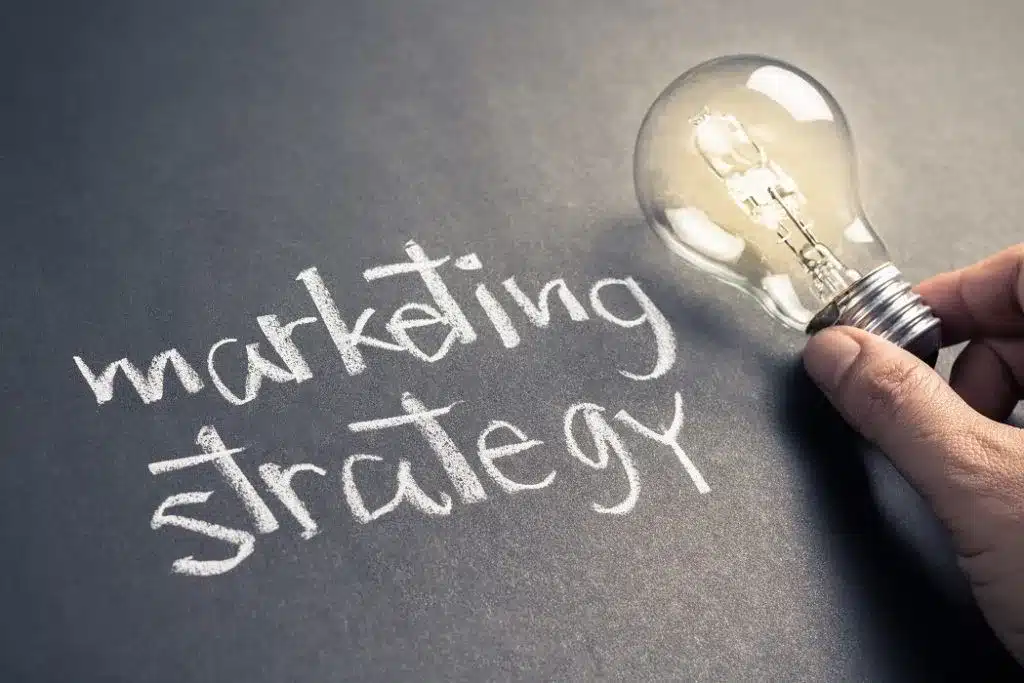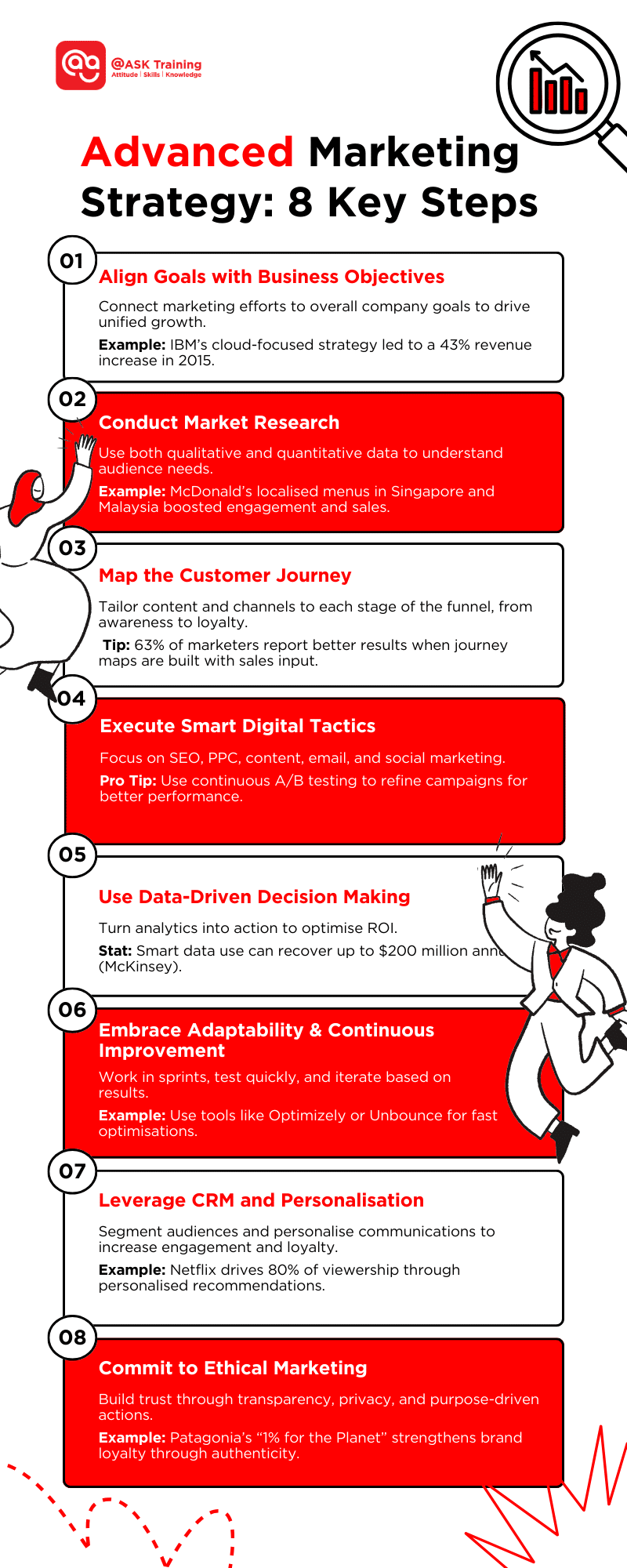Imagine trying to navigate a rapidly changing city with an outdated digital map. One that lacks real-time traffic, road closures, or new destinations. That’s what marketing without strategy feels like in today’s hyperconnected digital landscape.
Marketing has evolved from product-centric campaigns and newspaper ads / television commercials to a multifaceted practice that requires detail, strategy and foresight.
According to the State of Marketing Report by HubSpot, organisations with documented marketing strategies are 5.3x more likely to achieve their revenue goals compared to those without formal plans.
This demonstrates how strategic planning has become even more critical in today’s volatile digital landscape.
With consumer behaviour evolving at record speed, exacerbated by technology; an adaptable marketing strategy is no longer a luxury – it’s absolutely crucial. This article will guide you through every component of a modern marketing strategy, from foundational concepts to advanced execution.
By the end, you’ll have a blueprint to attract the right customers and grow sustainably. First, let’s clarify what we mean by ‘marketing strategy’.
What is a Marketing Strategy?
Credits: Corporate Finance Institute
A marketing strategy is more than a static plan and shouldn’t be set in stone; it’s a dynamic, evolving framework that bridges your brand’s current position with its desired future. Think of it as a roadmap guiding every decision, from messaging to media spends, ensuring each and every tactic aligns with overarching business goals.
Tony Hsieh, former CEO of Zappos: “Chase the vision, not the money; the money will end up following you.”
Key Insight: A well-defined marketing strategy keeps all teams: product, sales, and customer support, on the same page, so they move consistently toward the same goals. Without this alignment, even the best campaigns can feel disjointed and consequently underperform.
With this definition in mind, let’s explore why a marketing strategy isn’t just helpful, it’s non-negotiable for modern businesses.
Why is a Marketing Strategy Important?
Strategy provides both the compass for daily decisions and the engine for sustainable growth. Here are two main reasons why having a marketing strategy is important:
1. Aligns Business Goals with Customer Needs
A well-crafted marketing strategy does more than guide promotions—it becomes a blueprint for developing products and services that resonate. By deeply understanding customer behaviours (through purchase patterns, feedback, and market gaps), companies can identify unmet needs and innovate with precision.
Take Netflix’s evolution from DVD rentals to streaming dominance: their strategy wasn’t just about marketing existing offerings but recognising and acting on shifting consumer preferences for instant access.
2. Immediate Wins & Long-Term Gains
A marketing strategy drives short-term successes like traffic, lead generation, sales and revenue increases but more importantly, lays a foundation for long-term brand equity. When integrated into business objectives, it prompts cohesive, well-planned efforts that generate consistent results.
Case in Point: Nike’s “Just Do It” campaign, launched in 1988, wasn’t just a slogan. It was part of a comprehensive marketing plan with a broader strategy centred on empowering athletes of every level. From 1988 to 1998, Nike increased its share of the North American domestic sport-shoe business from 18% to 43%, from $877 million to a whopping $9.2 billion in worldwide sales. (Source: Campaign Asia)
3. Facilitates Team Alignment
When every department and individual understands the “why” behind each marketing action, it fosters unity and boosts productivity. A shared roadmap also makes it easier to secure leadership buy-in and resources – managers and stakeholders are more likely to fund initiatives that map to a clearly articulated business strategy.
Takeaway: Aim to articulate your marketing strategy in a clear, concise and vivid way – like a mission statement that resonates throughout the company. A clear marketing strategy, well-understood throughout the organisation, makes execution much easier. This reduces siloed efforts, wasted budgets, and misaligned messaging.
Now that we’ve established the ‘why’, let’s break down the ‘how’.
Basic Parts of a Marketing Strategy
Building an effective marketing strategy requires assembling five key building blocks. Each interdependent, like gears in a precision timepiece. From identifying your ideal customer to crafting an irresistible value proposition, these fundamentals create the foundation for all that follows.
Let’s dive into the basic parts of a marketing strategy.
1. Target Market & Customer Segmentation:
You can’t speak to everyone at once. Identify your ideal audience by diving deep into demographics, psychographics, and localised nuances. According to a study by MarketingSherpa, utilising buyer personas can lengthen visits by 900% and improve marketing-generated revenue by 171%. (Source: CleverX)
Why It Matters: Seasonality, culture, region and market-specific behaviours can drastically affect buying patterns. If you’re selling apparel, for instance, pinpointing countries with year-round cold climates or significant holiday seasons will shape your campaign timelines and product offering. Personas will also help you understand your audience – their needs, wants, demographics and psychographics better.
2. Unique Selling Proposition (USP) & Unique Value Proposition (UVP):
Your USP is what sets your brand apart in a saturated market. This should be clear, compelling, and customer-focused, rooted in authentic brand values like integrity, innovation, or quality. More importantly, it should make your customers feel or think a certain way.
But differentiation alone isn’t enough – you need to articulate why that uniqueness matters. This is where your Unique Value Proposition (UVP) comes in. While your USP identifies what makes you different, your UVP explains why that difference creates meaningful value for your customers.
Think of it this way:
- Your USP is the technical truth (“We use NASA-grade materials”)
- Your UVP is the strategic benefit (“Adventure without equipment failures – trusted by Everest climbers”)
Real-World Example: Airbnb’s USP initially revolved around “book unique homes instead of hotels” and their UVP focuses on the strategic benefit of “belonging anywhere”—an emotional promise that travellers could feel at home in any city. That unique angle turned Airbnb from a scrappy startup to a global disruptor of the hospitality industry, reaching US$11.1 billion in revenue in 2024 (Source: Wall Street Journal).
3. Marketing Channels:
Embrace an omnichannel approach that unifies traditional media (print, TV, radio) and digital platforms (social media, email, PPC). Different channels serve different purposes – some excel at creating awareness (e.g., Instagram, TikTok), while others are better for deep engagement (e.g., email newsletters). Nailing down the right channels and mapping out their different purposes takes time, market analysis and data, but will be rewarding once you see successes.
Here’s a quick look at it marketing channels that align with your business goals, with optimal channels:
| Goal | Best Channels |
| Awareness | Instagram, TikTok, Google Display Ads |
| Consideration | YouTube, Pinterest, SEO |
| Conversion | Google Search Ads, Retargeting, Email |
| Engagement | Email, LinkedIn, Web Push Notifications |
| Retention | Email, SMS, App Notifications |
Pro Tip: Assess which platforms your customers frequent most. A 2020 study by Omnisend found that marketers employing three or more channels in a single campaign achieved a 287% higher purchase rate than those using single-channel campaigns. (Source: Porch Group Media)
4. Branding, Brand Identity & Messaging
Your brand goes beyond a logo and tagline. It’s a consistent promise reflected in visuals, tone of voice, and customer interactions. Starbucks maintains its brand identity via uniformity in store aesthetics and product presentation worldwide, reinforcing its brand identity as a premium yet accessible “third place” between home and work.
While consistent visuals like Starbucks’ store aesthetics make your brand identifiable, strategic messaging proves you understand customer needs – like Slack promising to “make work less chaotic” for overwhelmed teams.
Key Benefit: While strong branding builds recognition, strategic messaging drives engagement by proving you understand customer needs. Together, they create trust that converts first-time buyers into advocates.
5. Performance Metrics: What is success?
Sales figures only paint part of the picture. To gauge how well your marketing strategy resonates, track customer acquisition costs (CAC), lifetime value (LTV), engagement rates, and conversion paths.
Stat to Note: According to the FP&A platform Cube Software, LTV/CAC ratio is a key metric for measuring sales and marketing ROI. They state that an ideal LTV/CAC ratio is 3:1, meaning for every dollar spent on acquiring a customer, the return should be three times that amount.
This ratio helps businesses understand their profitability and informs decisions on marketing budget allocation. Knowing these metrics helps you refine each step of the customer journey, making your strategy more precise and profitable.
Here’s a quick recap on the basic parts of a marketing strategy:
With the foundation set, it’s time to amplify your strategy with advanced techniques.
Advanced Steps to Craft a Robust Marketing Strategy
Now, let’s explore how to elevate your strategy. These advanced techniques help you anticipate market shifts, optimise resource allocation, and maintain competitive advantage.
1. Set Goals & Align with Business Objectives
Define what you want to achieve: whether it’s higher revenue, market share, brand awareness, or customer retention, then tie these aims to broader company goals. This approach encourages each department to work in harmony, from product development (meeting consumer demands) to finance (allocating budget effectively).
Industry Example: IBM’s significant growth in cloud revenue during 2015 can be largely attributed to its strategic realignment towards cloud services and other emerging technologies. In 2014, IBM outlined its “strategic imperatives,” focusing on cloud computing, analytics, mobile, social, and security sectors. This clear alignment with business objectives led to substantial outcomes:
- Cloud Revenue Growth: IBM’s cloud revenue reached $10.2 billion in 2015, marking a 43% increase from the previous year. IBM – United States
- Strategic Imperatives Contribution: Revenues from these strategic areas grew by 17% year-over-year, totalling $28.9 billion and accounting for 35% of IBM’s total revenue in 2015. IBM – United States
This deliberate focus on aligning marketing objectives with broader business goals underscores the effectiveness of setting clear strategic directions in driving revenue growth.
2. Conduct Market Research
Use both qualitative and quantitative methods – online surveys, focus groups, and analytics to understand your audience’s pain points and opportunities. Don’t overlook local market insights if you’re operating across regions. Something as simple as a holiday tradition can trigger demand spikes you’d miss with a one-size-fits-all approach.
Case in Point:
McDonald’s Singapore: Hawker-Inspired Burgers
- McDonald’s Singapore revived its hawker-inspired menu as part of Singapore’s National Day 2024 celebration, after meticulous research. This campaign demonstrates how to transform local insights into strategic wins.
- While specific sales figures are not provided, the campaign achieved its goals of enhancing brand appeal and engaging with local consumers.
McDonald’s Malaysia: Prosperity Burger
- McDonald’s Malaysia introduced the Prosperity Burger during the Lunar New Year season. This campaign shows how traditions inform product development.
- The campaign achieved remarkable success with the Prosperity Burger selling out within three weeks. There was a 2,638% improvement in Return on Advertising Spend (ROAS) during the campaign. (Source: MMA Global)
Key Learning: By conducting thorough market research, such as observation of local traditions (qualitative) and analysing sales data (quantitative), brands can gain valuable audience insights. These insights empower marketers like you to develop more targeted and effective marketing strategies.
3. Customer Journey & Funnel Mapping
Outline every phase customers go through, from awareness to advocacy. Each stage requires its own messaging, offers, and channels. Consider micro-moments; those split-second decisions where a well-timed email or paid ad can tip the scales in your favour.
Why It Works: ClearVoice Survey: Found that 63% of respondents with customer journey maps collaborated closely with sales teams during development, enhancing the effectiveness of these maps. ClearVoice
4. Digital Marketing Tactics
SEO, PPC, content marketing, social media, and email marketing form the backbone of modern strategies, especially in digital marketing. Master the art of keyword research to align with how people actually search for solutions. Ask, “What are they looking for?” and “How are they searching?” to ensure your brand appears at the right moment.
Pro Tip: Embrace continuous A/B testing. The best marketers treat campaigns like labs, running experiments, measuring impact, and refining to unlock incremental gains that add up over time.
5. Data-Driven Decision Making
Collecting data isn’t enough—you must interpret and act on it. Over time, consistent analysis can turn into an informed “gut instinct,” helping you quickly spot trends or anomalies in real time.
Stat Spotlight: Several McKinsey studies highlight the significant impact of data analytics on marketing performance:
- “Smart analytics” can tap up to 20% of lost ROI: McKinsey research indicates that better use of data can add $200 million annually to global marketing returns. (McKinsey & Company)
- Using marketing analytics to drive superior growth: An integrated analytics approach can free up 15 to 20 per cent of marketing spending, equating to as much as $200 billion globally per year.
6. Adaptability & Continuous Improvement
Markets evolve, trends shift, and competitors pivot; your strategy should too. Take a page from agile development: break down projects into sprints, review results, and adjust quickly. This iterative cycle of testing and learning keeps your marketing fresh and cost-effective.
For example:
Sprint-based execution allows marketers to test and optimise campaigns efficiently. You might run a two-week A/B test comparing two landing page variants, then analyse their click-through and conversion rates to determine the top performer before scaling it across your campaigns.
Use tools like Optimizely and Unbounce to make this process seamless. This enables quick iterations that drive measurable improvements.
Quote: “Marketing’s job is never done. It’s about perpetual motion. We must continue to innovate every day”, was said by Beth Comstock, GE’s former chief marketing and commercial officer.
7. CRM & Personalisation
Build lasting relationships by personalising communication and offers. Netflix’s recommendation engine, for example, personalises content for its 200+ million subscribers, driving 80% of viewership (Netflix Tech Blog). Personalised experiences breed loyalty, reduce churn, and increase customer lifetime value.
Action Step: Start simple by segmenting your email lists based on past purchasing behaviour. Offer tailored deals or recommend products that fit each segment’s interests, and watch engagement skyrocket.
8. Ethical Marketing Practices
Today’s consumers expect brands to uphold transparency, data privacy, and societal responsibility. The 2020 Edelman Trust Barometer revealed that 81% of consumers prioritise trustworthiness in their purchase decisions. Honesty pays off in both credibility and long-term customer loyalty.
Real Example: Patagonia’s “1% for the Planet” initiative—where it donates 1% of sales to environmental causes—positions the brand as a genuine steward of nature, reinforcing its authenticity and driving higher customer loyalty.
Here’s a summary of what we’ve discussed:
These strategy fundamentals and advanced approaches ultimately serve one purpose: creating a marketing engine that drives sustainable growth. Let’s conclude what we have discussed.
Wrapping Up
A well-crafted marketing strategy is more than a roadmap—it’s the central nervous system of your brand’s growth, ensuring every campaign, message, and interaction moves you closer to your vision. From setting aligned goals and researching local nuances to mapping the customer journey and refining tactics through data, the process is both art and science.
Actionable Next Steps:
- Audit your current marketing efforts to see if they align with bigger company objectives.
- Conduct a fresh round of customer research. Listen closely to what your audience needs right now.
- Review your metrics, from CAC to LTV, and make sure you’re tracking meaningful data.
- Build flexibility into your plan—experiment, measure, adapt, repeat.
Remember: The strongest strategies evolve with the market, continuously tested against real-world data and customer feedback. Start with a clear vision, then refine it relentlessly. Over time, you’ll develop not just a sound strategy but a thriving, resilient brand.
Recommended Resources
- Google Analytics Academy for foundational data skills.
- HubSpot Blog for in-depth guides on persona building and inbound marketing.
- Neil Patel’s Ubersuggest for keyword research and SEO insights.
- Seth Godin’s “This Is Marketing” for a fresh perspective on customer empathy.
Stay curious and keep iterating, because in marketing—like in life—the journey is every bit as important as the destination.
Ready to Transform These Strategies into Results?
While understanding marketing strategy is crucial, true mastery comes from applying these concepts to real business challenges.
@ASK Training can be your ally in this journey! Choose your path with our range of Digital Marketing courses, combining theory with hands-on execution.
Full Qualification Programmes
- Diploma in Digital Marketing: Master end-to-end campaign management while building a real-world digital marketing campaign as your capstone project.
- Specialist Diploma in Digital Marketing: Be an expert with advanced digital marketing strategies through real-world hands-on projects.
Modular Courses (Focused Learning, Flexible)
- Social Media Marketing Courses: Gain platform-specific expertise to create, optimise, and measure social media campaigns.
- Content Creation Courses: Learn to produce engaging, multi-format content that speaks to your audience.
- SEO, Website Analytics & Optimisation Courses: Equip yourself with technical SEO and data analysis skills through website audits and performance optimisation.
The best learning happens by doing! Get in touch with us to learn more!
Related Courses
- WSQ Diploma in Digital Marketing
- WSQ Specialist Diploma in Digital Marketing
- WSQ Advanced Digital Marketing Strategy
◆◆◆




